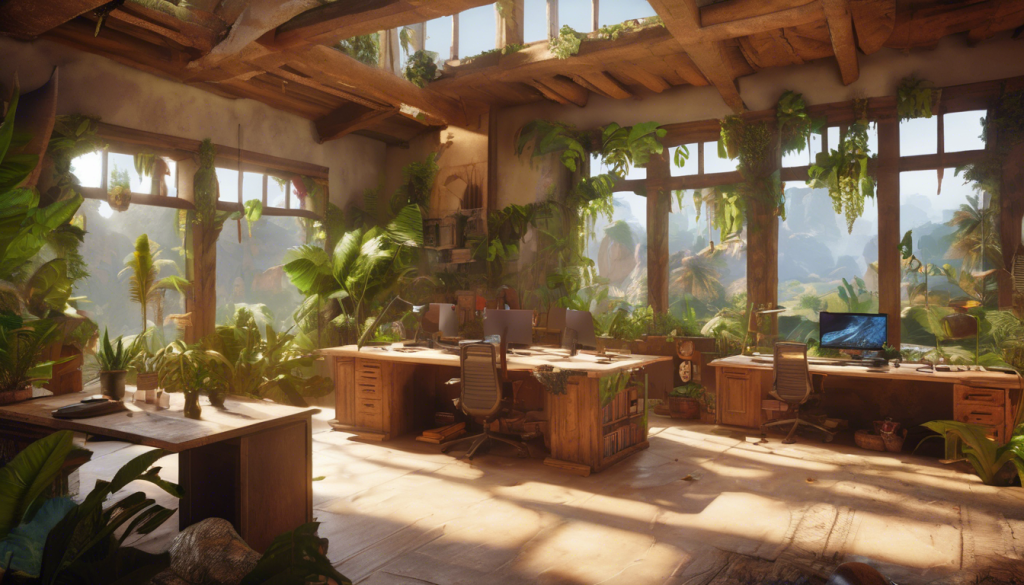
How Generative AI is Transforming the Gaming Industry in 2025
The $1.8 Billion Revolution: How Generative AI is Reshaping Gaming Development and Player Experiences
The gaming industry is experiencing a seismic shift as generative AI technologies redefine what’s possible for both developers and players. With the generative AI gaming market valued at approximately $1.8 billion in 2025 according to Intellias, we’re witnessing not just incremental improvements but fundamental transformations in how games are created, experienced, and monetized.
This isn’t just another tech buzzword u2013 it’s a practical reality already changing how games are made and played. From small indie studios suddenly capable of producing AAA-quality environments to established developers creating infinitely variable content, the impact is both immediate and far-reaching.
Market Growth and Adoption: The Numbers Tell the Story
The scale and pace of generative AI adoption in gaming reveal just how significant this shift has become:
- Current Market Value: The generative AI gaming market reached $1.81 billion in 2025, as reported by Google Cloud.
- Projected Growth: Industry analysts at Intellias expect the market to grow at a compound annual growth rate (CAGR) of more than 25%, potentially reaching over $11 billion by 2033.
- Developer Adoption: Over a third of game developers are already utilizing generative AI tools in their workflows, according to Intellias.
- Asset Generation Shift: By 2025, an estimated 60% of mobile game assets are expected to be AI-generated, dramatically reducing production costs, as noted by Google Cloud.
What This Means For You: Whether you’re a gaming industry professional, aspiring developer, or avid gamer, these numbers indicate that generative AI isn’t a future possibility u2013 it’s actively reshaping the industry today. The technology is becoming essential rather than optional for competitive game development.
Transformative Applications Changing Game Development
1. Procedural Content Generation on Steroids
Generative AI has supercharged procedural content generation (PCG), enabling the creation of vast, intricate environments without requiring massive development teams.
- Tools Leading the Way: Unity’s Muse and Meta’s NeRF are transforming 2D images into detailed 3D environments, allowing small studios to produce content that previously required much larger teams and budgets, according to Google Cloud.
- Cost Impact: The automation of asset creation significantly reduces development costs, with AI tools generating environments, characters, and levels procedurally, as highlighted by Bernard Marr.
“AI Dungeon 2 uses OpenAI’s GPT-3 to generate infinite text-based adventures, allowing players to create unique storylines by providing prompts”
– as highlighted by Appinventiv.
2. Dynamic Storytelling and NPCs
AI is revolutionizing how stories unfold and how non-player characters (NPCs) behave in games:
- Adaptive Narratives: Games can now feature stories that genuinely adapt to player choices and behaviors, creating personalized experiences, according to Appinventiv.
- Smarter NPCs: AI-driven characters can demonstrate more realistic behaviors and emotional responses, enhancing player immersion, as noted by Vocal Media.
Pro Tip:
Developers looking to implement AI-driven storytelling should start with limited scope applications focused on side quests or optional content before applying these technologies to main storylines.
3. Testing and Quality Assurance
Generative AI is transforming how games are tested and debugged:
- Automated Bug Detection: AI systems can automatically identify potential issues, significantly reducing the time and resources required for quality assurance, according to Appinventiv.
- Predictive Testing: AI can predict where problems might occur based on patterns in code and player behavior, allowing for proactive fixes, as reported by RBC News Ukraine.
Success Stories and Real-World Applications
Several games and tools demonstrate the practical impact of generative AI:
- Microsoft’s Muse: This generative AI model simulates gameplay sequences, enabling developers to ideate and expand game content. According to Vocal Media.
- NVIDIA’s DLSS Technology: This AI-based technology improves graphics quality and frame rates in games like Cyberpunk 2077 and Control without requiring high-end hardware, making advanced gaming experiences more accessible, according to Appinventiv.
Challenges and Limitations
Despite its transformative potential, generative AI in gaming faces several significant challenges:
1. Technical and Computational Barriers
- Hardware Requirements: Generating realistic environments demands powerful hardware, large datasets, and significant processing time, as noted by Vocal Media.
- Cost Considerations: The need for high-performance GPUs and prolonged training times represents a significant barrier, especially for smaller studios, according to Vocal Media.
2. Creative Limitations
- Narrative Depth: AI still struggles to generate complex, meaningful narratives essential for engaging storytelling in games, as highlighted by Vocal Media.
- Consistency Issues: AI-generated worlds can lack coherence and relevance to the game’s context, potentially disengaging players, according to Vocal Media.
3. Ethical and Legal Considerations
- Copyright Concerns: The use of AI to generate content raises questions about intellectual property rights and potential copyright infringement, as noted by Mike Shouts.
- Job Displacement: The automation of creative tasks raises concerns about potential job losses in certain areas of game development, according to Google Cloud.
What This Means For You: While generative AI offers exciting possibilities, it’s important to approach implementation with awareness of these limitations. For small studios or independent developers, focusing on specific applications where AI can add value without overwhelming resources may be the most practical approach.
Regulatory Frameworks Affecting Generative AI in Gaming
As generative AI continues to transform gaming, regulatory frameworks are evolving to address associated challenges and risks:
1. European Union AI Act
The EU AI Act, finalized in December 2023, is the first comprehensive legal framework for AI globally. According to WeAreDevelopers Magazine, it categorizes AI systems into different risk levels, with high-risk systems subject to strict obligations. While not specifically addressing gaming, its provisions on transparency, accountability, and human oversight will apply to AI systems used in gaming.
2. United Kingdom Online Safety Act
The UK’s Online Safety Act (OSA) regulates online services, including generative AI tools. Ofcom’s explanation indicates it requires providers to assess and mitigate risks related to illegal content and children’s access. Generative AI tools in gaming that enable user-to-user sharing or search services will fall under the OSA.
3. Intellectual Property Considerations
There is ongoing debate about the copyright of AI-generated works, which is a critical issue for the gaming industry. According to Michalsons, countries are still developing clear rules on this topic, creating uncertainty for developers using generative AI.
What This Means For You: Game developers and companies implementing generative AI need to stay informed about evolving regulations in different jurisdictions. Implementing transparent practices regarding AI-generated content and ensuring compliance with regional requirements will be essential for avoiding legal complications.
The Future of Generative AI in Gaming
Looking ahead, several trends are likely to shape how generative AI continues to transform gaming:
1. AI-Native Game Companies
A new wave of game developers built around AI capabilities from the ground up is emerging, potentially disrupting traditional development approaches with innovative games that would be impossible without AI, according to Google Cloud.
2. Hyper-Personalization
Games will increasingly adapt to individual player preferences, creating experiences that evolve based on play style, preferences, and even emotional responses, as predicted by CGM Magazine.
3. Blending with Other Technologies
The combination of generative AI with AR/VR technologies promises to create hyper-immersive experiences with infinitely customizable worlds tailored to individual preferences, according to Google Cloud.
4. Evolution of Game Design Roles
Rather than replacing human creativity, AI tools are likely to transform how designers work, shifting focus from repetitive tasks to higher-level creative direction and curation, as noted by RBC News Ukraine.
> “AI will permeate nearly every stage of game development, leading to more immersive, personalized, and intelligent experiences” – as noted by Google Cloud.
Getting Started with Generative AI in Gaming
For those looking to explore or implement generative AI in gaming, here are some practical starting points:
For Developers:
1. Explore Existing Tools: Platforms like Unity’s Muse, Microsoft’s AI tools, and NVIDIA’s technologies offer accessible entry points for implementing generative AI.
2. Start Small: Focus on implementing AI for specific elements like background environments or non-critical NPCs before tackling core gameplay.
3. Consider Hybrid Approaches: Combining human creativity with AI-generated content often yields the best results, especially for narrative and character development, as suggested by RBC News Ukraine.
For Players:
1. Explore AI-Enhanced Games: Games like No Man’s Sky and AI Dungeon showcase the potential of generative AI for creating unique experiences.
2. Provide Feedback: As more games incorporate AI features, player feedback becomes crucial for refining these technologies.
3. Stay Informed: Understanding how AI is used in games can enhance appreciation for technical achievements and help identify potential concerns.
Conclusion: A New Era of Gaming
Generative AI represents not just a technological advancement but a fundamental shift in how games are conceived, created, and experienced. While challenges remain in terms of technical limitations, creative applications, and regulatory frameworks, the trajectory is clear: AI will continue to transform gaming in increasingly profound ways.
For developers, the technology offers new creative possibilities and efficiency gains. For players, it promises more personalized, dynamic, and immersive experiences. And for the industry as a whole, it opens new business models and ways of engaging audiences.
As we navigate this transition, balancing technological innovation with human creativity will be essential. The most successful implementations will likely be those that use AI to enhance rather than replace human ingenuity, creating experiences that would be impossible through either approach alone.
What generative AI gaming experiences have you encountered, and how do you see these technologies shaping the future of games? Share your thoughts and experiences in the comments below.
Further Reading:
1. Generative AI and Open World Games: A New Era in Gaming
2. How AI Will Revolutionize the Gaming Industry
3. Game Development Trends in 2025


